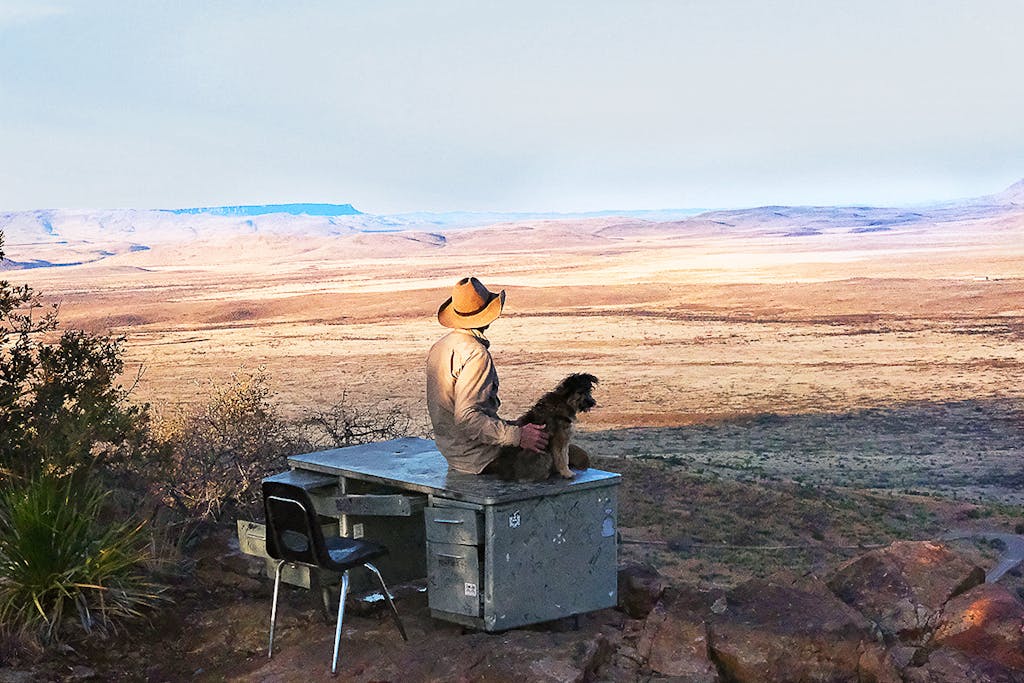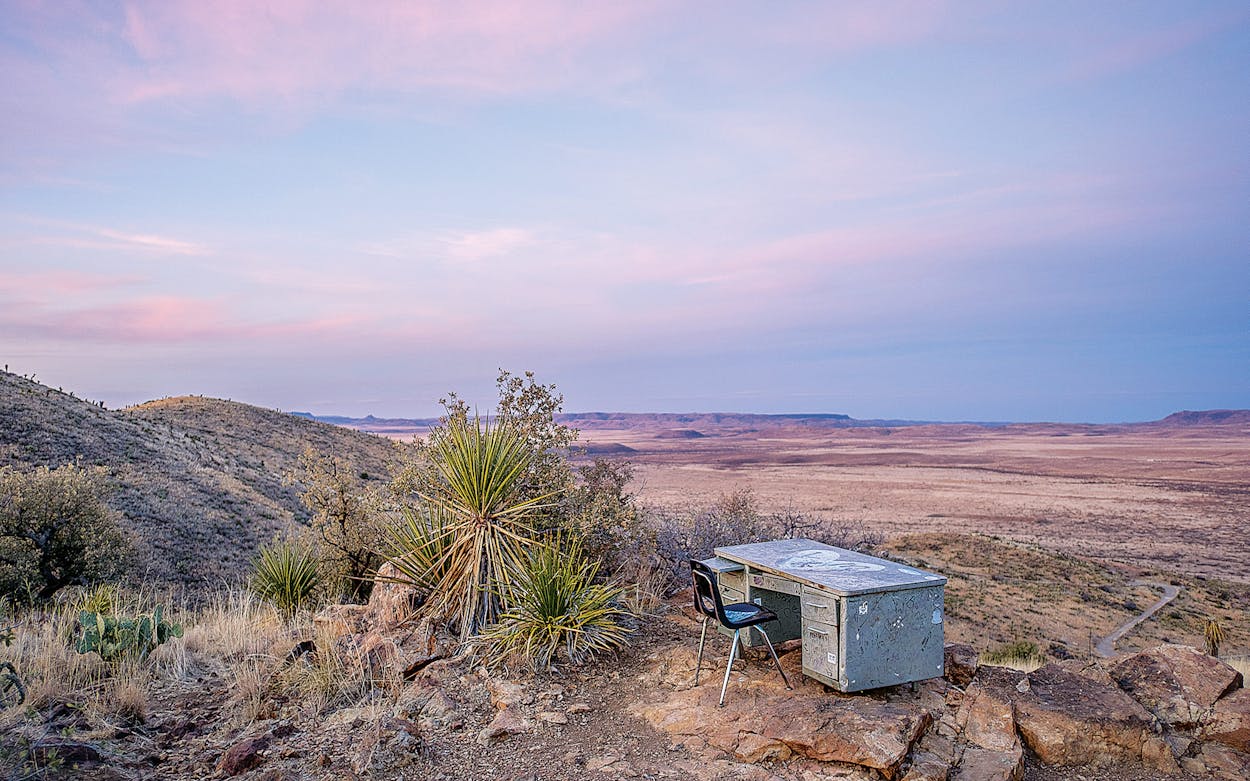The desk on the top of Hancock Hill is metal and dark gray, maybe from the sixties. Its drawers are banged up, and its top is graffitied with initials. When you get to the desk, someone might already be there, and that’s okay, because they’ll likely leave pretty soon and you’ll have the desk to yourself, which is nice. You can be alone with the view and the wind and the sky. You can think big thoughts. You can daydream. It’s there for you.
Hancock Hill is long and saddled and ripples down in folds. The hill is the lovely backdrop to Sul Ross State University, in Alpine, rising directly behind the school’s dorms and reaching an elevation of 4,849 feet, about 350 feet above the campus below. The southern side of the hill is owned by the university, and from the Hancock summit, a great tan-colored plain stretches out to the east, toward Marathon and the Glass Mountains. To the west are the school’s red-brick buildings and the little city of Alpine. Mountains to the south, the west, and the north. This weathered place, with its yellow grass and many rocks iron-colored and red, is the result and remnant of a lava flow that occurred 37 million years ago.
In more recent geologic time, a distance runner on the Sul Ross track team named Jim Kitchen was fond of chugging up Hancock Hill when he was a student. This was 1979, and Kitchen was twenty. One of his campus jobs involved culling outdated dorm furniture. One day, an idea struck him. “I had made trails up that hill, cut cactus and made paths, and I was running it three or four times a week,” he says. “I thought, ‘It’d be really cool to have a desk up there.’ ” Kitchen picked out a desk, a heavy, stout thing, from the surplus pile and tried moving it by himself. He didn’t get very far before cajoling two friends to help him lug it to the top of the hill. “We did it at night,” Kitchen says. “I thought I’d get in trouble for stealing a desk. I never told anybody and told those guys, ‘You gotta be real quiet about this.’ ”
He stashed a notebook in the desk’s drawer so he could track his run times. He’d also, on occasion, feel compelled to jot down his thoughts on those pages. He showed the track team the desk, and they began visiting. Slowly, through word of mouth, others found it too. More people started writing in the desk’s journal. The first notebook ran out of blank pages. Then a second one and a third. “Whenever they’d get filled up, we’d take them away and put a new one in there,” Kitchen says. “It really surprised me, the things that were written—pretty moving stuff. This was all before the internet. We weren’t socially connected like we are now. But people were making a connection to nature and to each other in those notebooks. It became something pretty special.”
Sul Ross’s Archives of the Big Bend is now the keeper of the journals, which are still picked up and replaced periodically. Most of the writers are anonymous, though the notebooks’ content is remarkably consistent: lots of “BFFs forever” statements, inside jokes, prosaic advice, mentions of drunkenness, rough drawings. Over time, the “We were here” category of comments has become more common than longer, more thoughtful entries. Still, people really spill their guts.
Various declarations of love abound: friend, family, romantic. “I’ve been blessed to meet someone with the beauty this mountain has,” Tony wrote, in tiny, cramped print, in honor of his new acquaintance, Claudia. “Maybe through the chimes of time we will undertake the beauty of life and love.” “Oliver loves Leo” is another. Directly below is a response, from a different hand: “(Leo also loves Oliver.)”
Loss of Words
The oldest Hancock Hill notebook entry at the Archives of the Big Bend dates to 1991. The whereabouts of the first decade of notes are unknown.
There are memories of epic events: “Pearl Harbor Day! We still remember after 78 years.” Many writers mention their appreciation of both the nearly overwhelming beauty in all directions and the friends who have accompanied them. These are a gentle salve to the heart, reminders during a tumultuous time of political unease and cultural sniping that simple presence together brings simple joy. “To take this moment here on this beautiful mountain does refresh the spirit and make the journey well worthwhile,” wrote one visitor in 1992. “The sun is warm upon my back and friends—good friends—are sitting on the nearby outcropping and peace is settling upon my soul.”
A number of visitors write thoughts that might not be released elsewhere. “My dad died when I was three,” a girl posted in 1997. “My mom got remarried six months ago. I really don’t love him that much but he is ok.” A proprietary sense seeps into a few journal entries. “I like to think that this place is all to me and that I don’t have to share it,” someone penned. “This is one of the few places on earth that you look at, without one building or anything on it. I think that is neat—untouched land.”
Some visitors go to the desk looking for refuge from grief or seeking clarity in navigating life’s complicated circumstances. “It’s been 169 days since my dearest Donnie passed,” one wrote in December 2019. “Yesterday would have been your 74th birthday. I miss you so very much. I love you so very much. I cry for you every day. It doesn’t get any easier.”

What is it about the desk that allows such personal glimpses into anonymous souls? Is it because when faced with that outrageous sky, the sotol and prickly pear and grassland far below, people inherently turn to thinking about the vast questions in their own lives? Whatever it is, what happens in those notebooks feels important and authentic. “The candor of the journals encouraged me to think more deeply about what I felt and cared about,” says Alpine resident Pam Gaddis, a longtime visitor to the hill. “In a sense, we are all writing for each other, all voicing our piece of the human experience.”
If the desk itself is a destination, then locating it becomes a mission. “We finally found this stupid thing again!” a nameless journaler declared. “We came up here just to drink beer, God only knows why we picked here.”
For a long while, the way to the desk has gone unmarked. There are multiple trails winding up and around Hancock, and while it’s easy to stay oriented—the surrounding mountains are landmarks that never move—the hill undulates in such a way that accidental backtracking or sidetracking or inadvertent looping is possible, or possibly inevitable, even for veteran Hancock climbers. To add to the confusion, the desk sometimes moved in the early years. “Members of the rodeo team used to go up there and drag it somewhere new with horses,” remembers Kitchen. Its location still shifts, though not by much. Kevin Urbanczyk arrived at Sul Ross as a student in 1982 and has taught geology there since 1991. He’s been up Hancock Hill hundreds of times and is among the volunteers who maintain its chief trails and remove trash and graffiti. “Occasionally the desk still gets moved because people decide they want to move it,” he says. “Four or five years ago, the football team put a new desk on the hill, but in a really different place, kind of facing Alpine. That one’s not up there anymore.”
When the desk gets too bashed and decrepit, it’s hauled down the hill and replaced with another. The current desk, Urbanczyk believes, is the fourth such iteration. About fifteen years ago, someone hung bicycles in a tree in an oaky nook atop the hill, as a sort of sculpture, which seemed to anchor the desk to that general location, more or less. If the desk itself is a destination, then locating it becomes a mission, as multiple journal entries attest. “We finally found this stupid thing again!” a nameless 1991 journaler declared. “We came up here just to drink beer, God only knows why we picked here.”
It may surprise some that despite the presence of mountains and hundreds of square miles of ranchland, as well as national and state parks within the region, most local folks don’t have much quick, easy access to open country. The ranchland is privately owned, and the parks may be too far for an afternoon outing. “There’s no other public property around here that gets you out so you have a little feel of the backcountry,” Urbanczyk says. “We have trails in the city park, but they’re paved. For Marfa and Alpine, Hancock Hill is what we have.”
There are two main trails. One starts roughly behind the school’s physical plant, near a former dorm called Mountainside Residence Hall. In 2000, Urbanczyk and others developed a second trail, which begins near a dorm called Lobo Village. This one was carefully designed in a sustainable fashion, with water runoff, gradients, and minimal scarring of the land in mind. Half the fun is getting a little lost finding the desk, but more and more, newbie visitors are inadvertently following paths that flow onto private property or straying off course and knocking on strangers’ doors for directions. In response to increased visitor numbers, the Alpine tourism office, the local parks board, and Sul Ross are working together on signage and maps that will be available online and at the tourism office later this year. “It’s a treasure up there,” Urbanczyk says. “Signage will both help people and protect the hill.”

It’s hard sometimes to look up when you’re hiking. Changing terrain and scree on the path call for concentration. There’s plenty to notice at your feet, though: electric-green lichen on a copper-colored stone, a secret wee fern wedged into a shady pocket of rock, fox scat containing seeds, javelina tracks. Pause for a moment to catch your breath and look up to notice the small forest of sotol, with their stiff blond summer stalks still intact, on the sunny, south-facing slope. Has the sky ever been that blue before? Bear right at the rock pile, past the grama grasses gone palest gold in winter.
From afar, this is just an old hill, yellow and pocked with prickly pear and yucca. Up close, there’s an abundance of life and diversity. Cholla and gray oaks and clay-green agaves within a few yards of one another, lechuguilla and Spanish dagger and a low-growing, malevolent-looking round cactus bunched nearby. Come upon a family, arguing agreeably about which way to the desk. Point grandly, theatrically, for them to go back the way they’ve come. More gray oaks on this protected north-side cleft, more large rocks, nearly boulders. Swing down toward an outcrop, past the bicycle tree, and there’s the desk and a black plastic chair at the edge of the hill, with that ocean of grassland below. The family trudges in, celebrates, jots down a note, and pokes around a bit before taking off again. The afternoon goes quiet. The wind riffles. At the top of the hill there is a desk and a chair.
This article originally appeared in the March 2020 issue of Texas Monthly with the headline “Letters to No One.” Subscribe today.
- More About:
- Alpine








